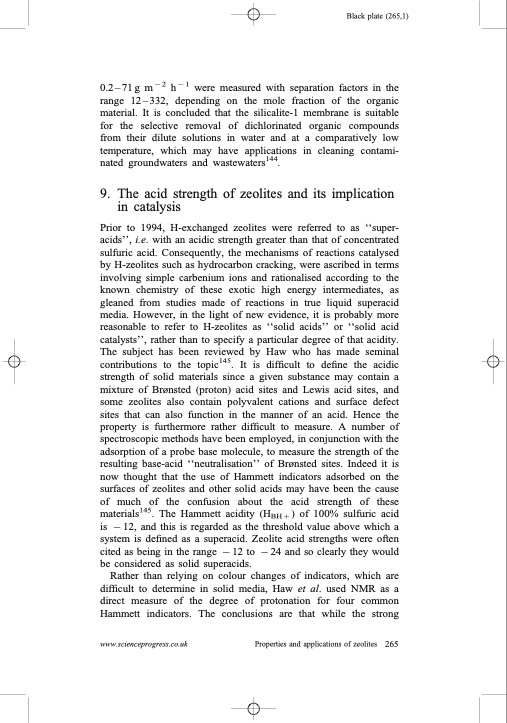
PDF Publication Title:
Text from PDF Page: 043
Black plate (265,1) 0.2 – 71 g m 2 h 1 were measured with separation factors in the range 12–332, depending on the mole fraction of the organic material. It is concluded that the silicalite-1 membrane is suitable for the selective removal of dichlorinated organic compounds from their dilute solutions in water and at a comparatively low temperature, which may have applications in cleaning contami- nated groundwaters and wastewaters144. 9. The acid strength of zeolites and its implication in catalysis Prior to 1994, H-exchanged zeolites were referred to as ‘‘super- acids’’, i.e. with an acidic strength greater than that of concentrated sulfuric acid. Consequently, the mechanisms of reactions catalysed by H-zeolites such as hydrocarbon cracking, were ascribed in terms involving simple carbenium ions and rationalised according to the known chemistry of these exotic high energy intermediates, as gleaned from studies made of reactions in true liquid superacid media. However, in the light of new evidence, it is probably more reasonable to refer to H-zeolites as ‘‘solid acids’’ or ‘‘solid acid catalysts’’, rather than to specify a particular degree of that acidity. The subject has been reviewed by Haw who has made seminal contributions to the topic145. It is difficult to define the acidic strength of solid materials since a given substance may contain a mixture of Brønsted (proton) acid sites and Lewis acid sites, and some zeolites also contain polyvalent cations and surface defect sites that can also function in the manner of an acid. Hence the property is furthermore rather difficult to measure. A number of spectroscopic methods have been employed, in conjunction with the adsorption of a probe base molecule, to measure the strength of the resulting base-acid ‘‘neutralisation’’ of Brønsted sites. Indeed it is now thought that the use of Hammett indicators adsorbed on the surfaces of zeolites and other solid acids may have been the cause of much of the confusion about the acid strength of these materials145. The Hammett acidity (HBH þ ) of 100% sulfuric acid is 12, and this is regarded as the threshold value above which a system is defined as a superacid. Zeolite acid strengths were often cited as being in the range 12 to 24 and so clearly they would be considered as solid superacids. Rather than relying on colour changes of indicators, which are difficult to determine in solid media, Haw et al. used NMR as a direct measure of the degree of protonation for four common Hammett indicators. The conclusions are that while the strong www.scienceprogress.co.uk Properties and applications of zeolites 265PDF Image | Properties and applications of zeolites

PDF Search Title:
Properties and applications of zeolitesOriginal File Name Searched:
003685010x12800828155007.pdfDIY PDF Search: Google It | Yahoo | Bing
CO2 Organic Rankine Cycle Experimenter Platform The supercritical CO2 phase change system is both a heat pump and organic rankine cycle which can be used for those purposes and as a supercritical extractor for advanced subcritical and supercritical extraction technology. Uses include producing nanoparticles, precious metal CO2 extraction, lithium battery recycling, and other applications... More Info
Heat Pumps CO2 ORC Heat Pump System Platform More Info
| CONTACT TEL: 608-238-6001 Email: greg@infinityturbine.com | RSS | AMP |